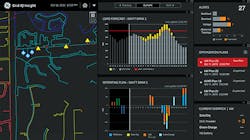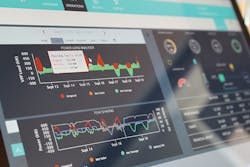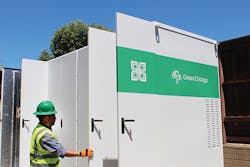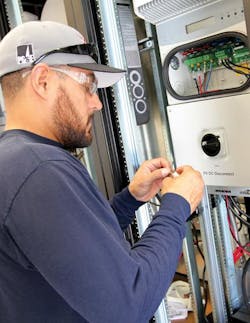For years, Pacific Gas and Electric Co. (PG&E) has discussed the grid of the future, envisioning a “Grid of Things” — like the Internet of Things — where interconnection adds tremendous value in virtually every part of people’s lives. The utility envisions a distribution grid platform that facilitates emerging energy technologies to be interconnected with each other and integrated into the larger grid.
PG&E supports the decarbonization of California’s energy system in the U.S., while maintaining a grid that is always on for its customers, whenever they need it. To drive toward this clean-energy future, PG&E continues to look toward innovation, integration of new technologies and collaboration. At the same time, the utility recognizes and supports the increasingly complex, dynamic energy needs as well as the desires of its customers, which include solar, energy storage, electrification of transportation and the achievement of California’s environmental and energy policy goals.
Distributed Energy Resources
Playing a central role in PG&E’s vision for the Grid of Things, where grid assets can interact with each other to optimize group coordination for the benefit of customers, are distributed energy resources (DERs). The utility views the rapid growth of DERs as the start of a new era of electric distribution, with a smarter grid emerging as a reliability, storage and interconnection system that complements new energy technologies. The nature of this change is profound, because it moves the electric power system’s one-way energy flow from a central power plant, designed more than a century ago, to a two-way energy system providing customers their own energy and putting the excess back onto the grid.
As this dynamic two-way operating environment develops, PG&E continues to embrace and test innovative technologies that improve electric reliability, and it equips customers with valuable services and products that support their choices to adopt clean energy. In this new environment, the role of utilities as owners and operators of the electric distribution grid becomes even more important as new products develop.
The ability to visualize distributed energy resources (DERs) in both a geographic and temporal sense is key to reliable distribution operations at increased DER penetration levels. Knowledge of the current and near-term forecasted states of the DERs is essential in order to understand potential threats and opportunities. The ability to coordinate utility and non-utility DERs is also required to effectively mitigate threats and seize opportunities. GE’s Grid IQ Insight provides the operator with the requisite situational intelligence to recognize developing situations and act quickly and decisively.
Necessary Changes
The distribution resources plan (DRP) addresses elements of PG&E’s efforts to integrate additional technologies and devices with the electric grid. The DRP will help to drive necessary changes to ensure the capability of safely and reliably increasing the adoption of DERs to achieve California’s energy policy objectives. Following is some background on PG&E’s transition to the new clean-energy environment:
• PG&E has more private solar than any other energy utility in the U.S., with more than 270,000 private solar customers connected to the energy grid. The utility connects approximately 6000 new solar customers to the grid monthly, or approximately one every seven minutes. This is more than any other utility in the world, and PG&E is leading the way with short interconnection times for customers.
- One in five electric vehicles in the U.S. is registered in PG&E’s service area. There are more than 200,000 electric vehicles in California and more than 85,000 in PG&E’s service area.
- PG&E operates the largest single-building electric vehicle-charging installation in the state of California at its Bishop Ranch campus in San Ramon.
- PG&E was the first utility to support AB-32, California’s long-term approach to addressing climate change.
- PG&E continues to report record success in many safety and reliability metrics. For example, the utility delivered record electric reliability to its customers for the seventh year in a row in 2015.
- Nearly 60% of the energy PG&E delivers comes from sources that emit no greenhouse gases. By the year 2020, PG&E expects this number will grow to approximately 65%.
Similarly, PG&E expects a dramatic increase of DERs connecting to its grid between now and 2025, making it essential to plan and enhance its grid thoughtfully to effectively address this growth. A smarter energy grid provides critical infrastructure for more clean-energy options, such as solar and electric vehicles.
Actions Taken
To address this growth, PG&E is taking actions through the Electric Program Investment Charge (EPIC), a program that enables California investor-owned utilities to develop smart grid technology demonstration and deployment projects, and to evaluate how they support safety, reliability and affordability objectives for the benefit of customers. In July 2016, PG&E announced the launch of multiple technology demonstration projects in San Jose, California, to advance the integration of DERs such as solar and battery storage.
Three EPIC-funded demonstration projects are co-located and coordinated on two feeders in San Jose. The smart inverter and energy storage projects will demonstrate deployment of behind-the-meter DERs and test utility dispatch of the resources. The third project will demonstrate a distributed energy resource management system (DERMS) in collaboration with GE’s Grid Solutions business. Through these projects, PG&E will evaluate how energy storage and smart inverters used with customer-sited solar can be controlled and coordinated through grid management technology.
SolarCity’s Grid Services product suite will be leveraged to aggregate residential solar paired with smart inverters and Tesla Powerwall batteries to provide grid benefits to PG
Major Goals
One major goal of the demonstrations is to evaluate to what extent the DERMS technology enhances the stability and power quality of the grid as well as optimizes solar generation and power-flow management as more customers adopt solar and energy storage. PG&E is collaborating with GE Grid Solutions, SolarCity and Green Charge Networks to execute these projects.
PG&E is teaming up with GE’s Grid Solutions business to execute the development of DERMS, which serves as the brain behind this technology project. GE has been providing control room solutions for years. Traditionally, the control room has connected a few hundred resources to the grid. Now it is headed toward connecting thousands of assets to the grid. This project will help to determine how to use those resources to help operational decision making, and for the first time, the control room will be interfacing with truly smart inverters.
PG&E is working with SolarCity to install and test smart inverters. PG&E will evaluate how smart inverters used with customer-sited solar can be controlled and coordinated with grid management technology. PG&E also is working with SolarCity to install and test battery storage systems for residential customers. This project involves two different vendors — SolarCity and Green Charge — integrating into a common platform. This is a peek into the future of grid management, thanks to PG&E’s leadership embracing collaboration and not trying to do it all internally.
In working with Green Charge to install and test battery storage systems for commercial customers, PG&E sees a great opportunity to learn collectively how best to work with DERMS and, in the process, drive standards and develop guidelines for this next-generation operating environment. The battery storage systems will interface with the DERMS to evaluate whether and how customer-sited energy storage can be used to support the grid operationally during periods of high electric demand.
The demonstration project also will coordinate third-party-owned energy storage with PG&E-owned storage, the 4-MW Yerba Buena battery energy storage system. Located next to a research facility in the San Jose foothills, the Yerba Buena battery can send reserve power to the grid when demand increases. PG&E will be evaluating how to make the day-to-day trade-off in maximizing the value of utility-owned storage, either by bidding into California’s International Organization for Standardization markets or dispatching to meet distribution-level needs.
Green Charge staff performs final safety inspection before bringing a 500-kW/1000-kWh system online in Southern California. Green Charge systems currently provide frequency regulation, voltage support and demand response, among other grid and customer services.
Multiple Objectives
The technology demonstrations include multiple objectives across the three projects:
- Testing smart inverter functionalities to support the grid at the distribution transformer level and below.
- Testing aggregated dispatch of behind-the-meter storage to shave the evening peak while providing benefits to the customers.
- Testing DERMS, which PG&E will operate in the demonstration mode for four to six months with the dispatched DERs to demonstrate potential use cases (as described below). Demonstration of the use cases is expected to help PG&E answer critical technology questions and plan investments to support the future high-DER penetration grid.
PG&E is seeking to demonstrate DERMS and obtain data on how the GE DERMS solution and the DERs can work together to provide solutions for high-DER penetration grid use cases, potentially including the following:
- Load masking and phantom load. Visualize actual and forecasted DER-related grid conditions in real time: native generation, native load, net generation, load and flexibility
- Manage equipment capacity constraints. Control DERs to mitigate overload issues dynamically through operational control (for example, increase load by charging energy storage, increase load on load control devices, or reduce generation by curtailing distributed generation production or storage output).
- Mitigate voltage issues with real power output. Leverage DER flexibility to resolve an existing voltage issue by altering real power output (for example, kilowatt curtailment of smart inverter output, and selective charging and discharging of dispatchable assets).
- Mitigate voltage issues with reactive power. Leverage smart inverter settings and functionality to generate reactive power to support voltage stability (for example, mode control of smart inverters to set power factor).
- Economic dispatch of distributed generation and energy storage. Dispatch distributed generation and energy storage based on economic factors such as cost or external pricing signals.
- Operational flexibility. Demonstrate that DERMS can be used to develop forecasts and optimizations during abnormal switching configurations.
As part of the DERMS demonstration, the DERMS solution will communicate with DER aggregators. DER dispatch schedules determined by DERMS and vetted by PG&E engineers will then be communicated to and executed by DER aggregators.
Enabling the Future
This technology demonstration will help to inform how PG&E approaches integrating third-party assets into distribution grid operations. PG&E sees DERMS as an enabler to the future state the DRP is seeking to create. PG&E believes DERMS is needed to enable the safe and reliable operation of the high-DER penetration grid of the near future. The demonstration commenced in September 2016 and is expected to end in December 2017.
Russ Griffith is part of Pacific Gas and Electric Co.’s grid integration and innovation team, where he leads evaluation of new technologies needed to operate the high-DERs penetration grid. Griffith is presently responsible for PG&E’s DER management system and volt/VAR optimization pilot projects. Prior to joining PG&E, he worked in the nuclear industry in the U.S. and the U.K. with Atkins, Bechtel and the U.S. Navy in a variety of engineering and operational roles.
Alex Portilla is a principal product manager in Pacific Gas and Electric Co.’s grid integration and innovation team, where he leads strategy development and project delivery for PG&E’s distributed energy resource management system pilot. Prior to joining PG&E, Portilla worked for the Innovation Centre Denmark, where he served as strategic advisor for Danish technology companies and organizations looking to raise capital, find collaboration partners or scale globally via Silicon Valley with exposure to a diverse set of clients coming from various cleantech subsectors.








